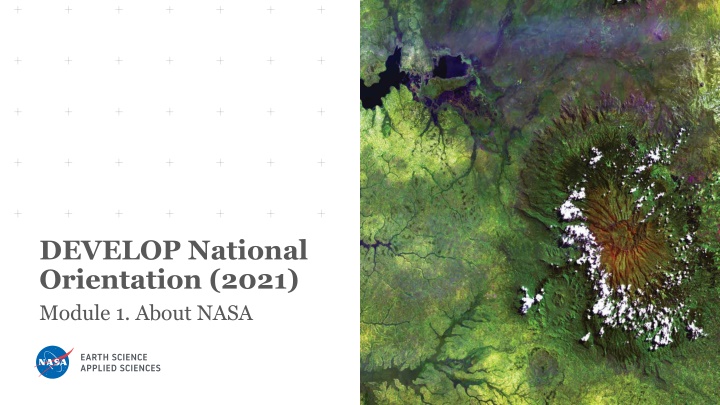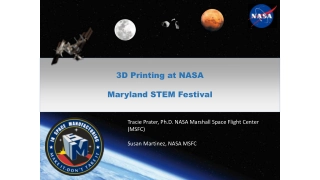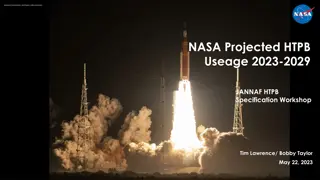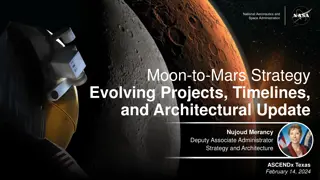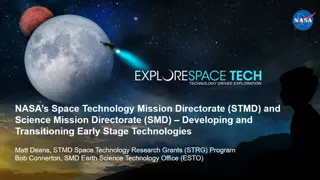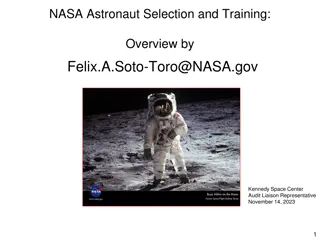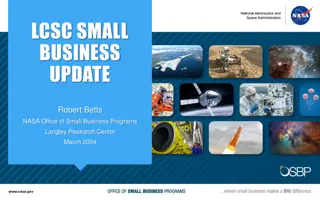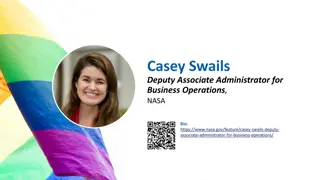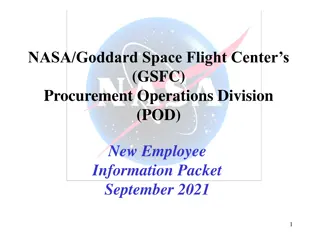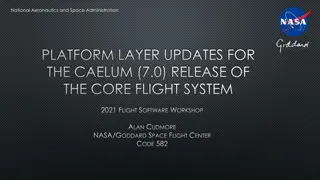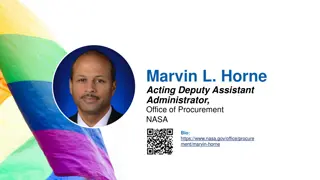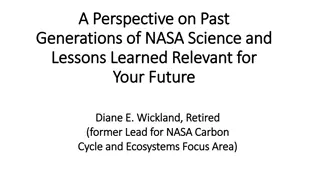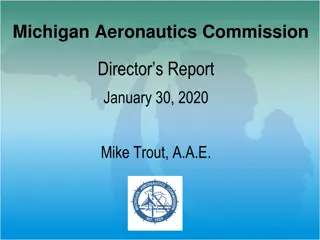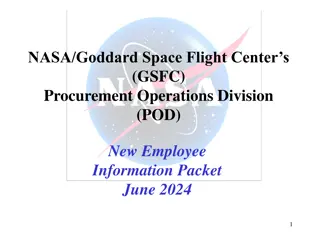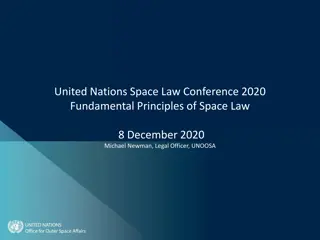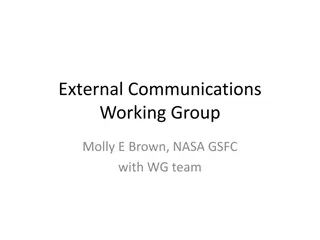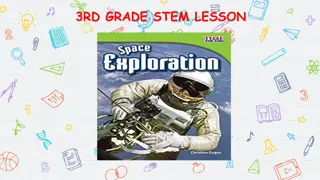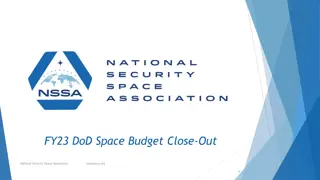National Aeronautics and Space Administration (NASA) Overview
Established in 1958, NASA is a key player in aeronautics, space technology, and scientific exploration. Learn about NASA's history, leadership, organizational structure, and mission directives spanning a wide range of scientific disciplines.
Download Presentation

Please find below an Image/Link to download the presentation.
The content on the website is provided AS IS for your information and personal use only. It may not be sold, licensed, or shared on other websites without obtaining consent from the author.If you encounter any issues during the download, it is possible that the publisher has removed the file from their server.
You are allowed to download the files provided on this website for personal or commercial use, subject to the condition that they are used lawfully. All files are the property of their respective owners.
The content on the website is provided AS IS for your information and personal use only. It may not be sold, licensed, or shared on other websites without obtaining consent from the author.
E N D
Presentation Transcript
DEVELOP National Orientation (2021) Module 1. About NASA
By The Way NASA celebrated its 60th birthday in 2018! ABOUT NASA NASA History "An Act to provide for research into the problems of flight within and outside the Earth's atmosphere, and for other purposes." With this simple preamble, the US Congress and President Dwight D. Eisenhower established the National Aeronautics and Space Administration on July 29, 1958. NASA began operations on October 1, 1958. It absorbed into itself the earlier National Advisory Committee for Aeronautics (NACA). Today, NASA has 10 Centers and multiple facilities around the country.
ABOUT NASA NASA Organization NASA Administrator Associate Administrator Mission Directorates Mission Support Aeronautics Research Human Exploration and Operations Space Technology Science Joint Agency Satellite Div. Heliophysics Division Planetary Science Div. Astrophysics Division Earth Science Division Applied Sciences Program Capacity Building Program ARSET DEVELOP SERVIR You are here!
ABOUT NASA NASA Leadership Col. (USAF, ret) Pam Melroy Robert Cabana Bill Nelson Sen. Bill Nelson NASA Administrator Colonel (USAF, ret.) Pam Melroy Deputy Administrator Melanie Saunders Dr. Thomas Zurbuchen Dr. Karen St. Germain Robert Cabana Associate Administrator Melanie Saunders Deputy Associate Administrator Thomas Zurbuchen, Ph.D. Science Mission Directorate Lawrence Friedl Dr. Nancy Searby Mike Ruiz Karen St. Germain, Ph.D. Earth Science Division By The Way Lawrence Friedl Applied Sciences Program Knowing key NASA leaders is important because you will see these people at conferences and events! Nancy Searby, Ph.D. Capacity Building Program Mike Ruiz DEVELOP National Program NASA Organization Chart: http://www.nasa.gov/about/org_index.html#.VBNBWvldWbM
ABOUT NASA By The Way Dr. Thomas Zurbuchen, AA for SMD and aka Dr. Z, is often seen at conferences and visiting NASA Centers! Follow him on Twitter! Science Mission Directorate Science is interconnected; no important question stands alone. The Science Mission Directorate (SMD) is an organization where discoveries in one scientific discipline have a direct route to other areas of study. This flow is something extremely valuable and is rare in the scientific world. SMD seeks to understand the origins, evolution, and destiny of the universe and to understand the nature of the strange phenomena that shape it by - Engaging the Nation s science community - Sponsoring scientific research - Developing and deploying satellites and probes in collaboration with NASA s partners around the world to answer fundamental questions requiring the view from and into space
ABOUT NASA Earth Science Division The Earth Science Division (ESD), conducts scientific studies to understand the Earth as a system on all time scales. ESD utilizes NASA s ability to view the Earth from the unique vantage point of space. ESD provides uniformly high-quality data covering the planet to support the pursuit of answers to fundamental science questions. There are four lines of business: Research & Analysis Flight Technology Applied Sciences Supports innovative and practical uses of Earth observations and scientific knowledge by private and public sectors to inform their planning, decisions, and actions. Tests and demonstrates scientific technologies for future satellite and airborne missions: Instruments, Information Systems, Components, In-Space Validation. Develops, launches, and operates NASA s fleet of Earth-observing satellites, instruments, and aircraft. Manages data systems to make the data freely and openly available. Supports research that advances knowledge of the Earth as a system. Six focus areas plus field campaigns, modeling, and scientific computing.
ABOUT NASA NASA Earth Observations (EO) NASA Earth Observing System (EOS) NASA Earth observations (EO): Umbrella term used that includes all airborne and flight missions that study the Earth. EOS is a specific program within NASA and EOS refers to a specific subset of the NASA Earth observing missions that are focused on long-term global observations of the land surface, biosphere, solid Earth, atmosphere, and oceans to improve understanding of the Earth as an integrated system. Current NASA Spaceborne EO Missions: 1. 2. Aura 3. CALIPSO 4. CloudSat 5. CYGNSS 6. DISCOVR 7. ECOSTRESS (on ISS) 8. GEDI (on ISS) 9. GPM 10. GRACE-FO 11. ICESat-2 12. Landsat 7 13. Landsat 8 14. LIS (on ISS) 15. OCO-2 16. OCO-3 (on ISS) Aqua 17. SAGE III (on ISS) 18. Sentinel-6 Michael Freilich 19. SMAP 20. Suomi NPP 21. Terra 22. TSIS-1 (on ISS) Only use this term when speaking exclusively to the below missions: Current EOS Missions: Aqua, Aura, Landsat 7, Terra Future Missions: Landsat 9, MAIA, NISAR, CLARREO Pathfinder, PACE, SWOT, TEMPO List of completed & current EOS missions: https://eospso.nasa.gov/mission-category/3 By The Way NASA pursues airborne campaigns in addition to its spaceborne missions. Some DEVELOP projects explore use of airborne data as well!
By The Way Lawrence Friedl, ASP Director, once worked at NASA Mission Control! ABOUT NASA Applied Sciences Program The Applied Sciences Program (AppSci) supports innovative and practical uses of Earth observations and scientific knowledge by private and public sectors to inform their planning, decisions, and actions. AppSci pursues: Partnerships with public and private organizations Discovery of innovative NASA Earth Science applications Support of environmental decision-making activities Demonstration of practical benefits of NASA Earth Science Help to improve the quality of life and strengthen the economy Emily Sylak-Glassman, Program Manager Lawrence Friedl, Director Three lines of business: Thematically- Organized Applications Capacity Building Program Mission Planning
ABOUT NASA Applied Sciences Programmatic Application Areas The Applied Sciences Program is structured around eight application areas Only five have full programs that routinely hold solicitations and have active investment portfolios at NASA HQ: DISASTERS WATER RESOURCES AGRICULTURE Dr. David Green Dr. Brad Doorn Additional three thematic areas: HEALTH & AIR QUALITY ECOLOGICAL FORECASTING URBAN DEVELOPMENT ENERGY TRANSPORTATION & INFRASTRUCTURE John Haynes Woody Turner Dr. Keith Gaddis
EMPOWERING PEOPLE & COMMUNITIES Making Earth Data Accessible to All 2020 REACH The Capacity Building Program provides individuals and institutions with workforce development, training activities, and collaborative projects to strengthen understanding of Earth observations and expand their use around the world. Through the ARSET, DEVELOP and SERVIR programs and the Indigenous Peoples Pilot project, CBP works with everyone at every level from first-time users to long-time professional users of Earth observation data. We promote open data access and coordinate capacity building activities focused on users needs. Capacity Building Program Webpage
CBP ELEMENTS ARSET DEVELOP SERVIR ARSET offers satellite remote sensing training that builds the skills to integrate NASA Earth Science data into decision- making activities. Through its decade of trainings, ARSET has reached over 25,000 participants from 160 countries and more than 5,000 organizations worldwide. DEVELOP addresses decision-makers needs through interdisciplinary feasibility studies that apply the lens of NASA Earth observations to environmental issues around the globe. SERVIR connects space to village by helping developing countries use satellite data to address critical challenges in food security, water resources, weather and climate, land use, natural disasters, and air quality. Projects build capacity to use Earth observations in participants and partner organizations through eight thematic areas during three terms a year. A partnership of NASA, USAID, and leading technical organizations around the world, SERVIR develops innovative solutions to improve livelihoods and foster self-reliance in Asia, Africa, and the Americas. https://servirglobal.net https://appliedsciences.nasa.gov/arset https://develop.larc.nasa.gov
ABOUT NASA Capacity Building Program: Leadership Element Leads Dr. Nancy Searby CBP Program Manager Ana Prados ARSET Project Manager NASAGoddard Greenbelt, MD Mike Ruiz DEVELOP Program Manager NASA Langley Hampton, VA Sydney Neugebauer CBP Coordination & Analysis Lead Christine Mataya CBP Program Support Specialist Dan Irwin SERVIR Program Manager NASA Marshall Huntsville, AL
ABOUT NASA Quiz Time How old is NASA? Who is the Associate Administrator of the Science Mission Directorate? What s the difference between EO and EOS? Who is Lawrence Friedl? Which of DEVELOP s sister programs focuses on providing trainings and which focuses on international capacity building?
Thank You. Joining the DEVELOP family means being part of NASA s Legacy. Learn it. Know it. Live it.
